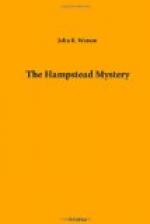“I didn’t believe his story, though Miss Fanning did, but he stuck to it and seemed so frightened that I thought there might be something in it till he brought out that he’d lost his revolver somewhere. Then I remembered the horrid threats he’d used against Sir Horace, and I was convinced that he had committed the murder. But of course I dared not let him think I suspected him, and I pretended to console him. But the feeling that kept running through my head was that both of us would be suspected of the murder.
“I told this to Birchill, and that frightened him still more. ’What are we to do?’ he kept saying. ‘We shall both be hanged.’ Then, after a while, we recovered ourselves a bit and began to look at it from a more common-sense point of view. Nobody knew about Birchill’s visit to the house except our two selves and the girl, and there was no reason why anybody should suspect us as long as we kept that knowledge to ourselves. Birchill’s idea, after we’d talked this over, was that I should go quietly home to bed, and pay a visit to Riversbrook on Friday as usual, discover Sir Horace Fewbanks’s body, and then tell the police. But I didn’t like to do that for two reasons. I didn’t think that my nerves would be in a fit state to tell the police how I found the body without betraying to them that I knew something about it; and I couldn’t bear to think of Sir Horace’s body lying neglected all alone in that empty house till the following day—though I kept that reason to myself.
“It was the girl who hit on the idea of sending a letter to the police. She said that it would be the best thing to do, because if they were informed and went to the house and discovered the body it wouldn’t be so difficult for me to face them afterwards. I agreed to that, and so did Birchill, who was very frightened in case I might give anything away, and consented on that account. The girl showed us how to write the letter, too—she said she’d often heard of anonymous letters being written that way—and she brought out three different pens and a bottle of ink and a writing pad. After we’d agreed what to write, she showed us how to do it, each one printing a letter on the paper in turn, and using a different pen each time.”
“You took care to leave no finger-prints,” said Inspector Chippenfield.
“We used a handkerchief to wrap our hands in,” said Hill. “Birchill got tired of passing the paper from one to another and wrote all his letters, leaving spaces for the girl and me to write in ours. When the letter was written we wrote the address on the envelope the same way, and stamped it. Then I went out and posted the letter in a pillar-box.”




